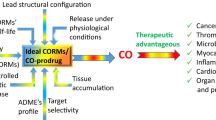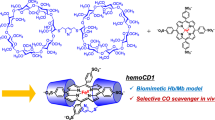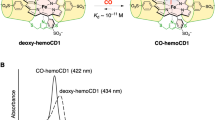Abstract
In studying CO for its pathophysiological roles, four metal/borane-carbonyl complexes have been widely used as CO-releasing molecules (CORMs) because of their commercial availability. The CO-release properties of CORM-2, CORM-3, and CORM-A1 have been rigorously characterized. In this study, we characterize CORM-401 for its CO-donating ability under various conditions relevant to studying CO biology. First, with regard to the “intrinsic” CO-release ability of CORM-401 and factors that could influence such ability, we found significant effects of added reagents such as thiol, peroxide, and dithionite on CO-release yields and rate. The variable nature of CO release from CORM-401 indicates the need for predetermining CO production yield and rate under the same conditions before biology experiments. Second, because of the commercial availability of CORM-401 in DMSO stock solution, we characterized its stability in such a preparation and found significantly diminished CO-release capacity of CORM-401 after exposing to DMSO or aqueous solution. Third, because carboxyhemoglobin (COHb) is an important indicator of the ability for a CO donor to supply CO in animal model work, we characterized the property for CORM-401 to elevate COHb. Fourth, quality assurance of such a metal complex is important to ensure consistency in results. Our findings indicate that the unstable nature of CORM-401 presents a quality assurance issue for end users. All these combined with the previously reported chemical reactivity of CORM-401could lead to intractable scenarios in obtaining meaningful results using CORM-401 that can be reasonably attributed to CO in biology experiments.




Similar content being viewed by others
References
Wu L, Wang R. Carbon monoxide: endogenous production, physiological functions, and pharmacological applications. Pharmacol Rev. 2005;57:585–630. https://doi.org/10.1124/pr.57.4.3
De La Cruz LKC, Wang B. Carbon monoxide production: in health and in sickness. In: Wang B, Otterbein LE, editors. Carbon Monoxide in Drug Discovery: Basics, Pharmacology, and Therapeutic Potential. Wiley Series in Drug Discovery and Development: John Wiley and Sons, Hoboken, New Jersey; 2022. 302–18
Coburn RF. The carbon monoxide body stores. Ann N Y Acad Sci. 1970;174:11–22
Wang B, Otterbein L. Carbon monoxide in drug discovery: basics, pharmacology, and therapeutic potential. 1 ed. Wiley Series in Drug Discovery and Development. Wiley; 2022
Kashfi K, Patel KK. Carbon monoxide and its role in human physiology: a brief historical perspective. Biochem Pharmacol. 2022;204:115230. https://doi.org/10.1016/j.bcp.2022.115230
Motterlini R, Otterbein LE. The therapeutic potential of carbon monoxide. Nat Rev. 2010;9:728–43. https://doi.org/10.1038/nrd3228
Bauer N, Yuan Z, Yang X, Wang B. Plight of CORMs: the unreliability of four commercially available CO-releasing molecules, CORM-2, CORM-3, CORM-A1, and CORM-401, in studying CO biology. Biochem Pharmacol. 2023;214:115642. https://doi.org/10.1016/j.bcp.2023.115642
Santos-Silva T, Mukhopadhyay A, Seixas JD, Bernardes GJL, Romão CC, Romão MJ. CORM-3 reactivity toward proteins: the crystal structure of a Ru(II) dicarbonyl−lysozyme complex. J Am Chem Soc. 2011;133:1192–5. https://doi.org/10.1021/ja108820s
Southam HM, Williamson MP, Chapman JA, Lyon RL, Trevitt CR, Henderson PJF, et al. Carbon-monoxide-releasing molecule-2 (CORM-2)’ is a misnomer: ruthenium toxicity, not CO release, accounts for its antimicrobial effects. Antioxidants. 2021;10:915. https://doi.org/10.3390/antiox10060915
McLean S, Mann BE, Poole RK. Sulfite species enhance carbon monoxide release from CO-releasing molecules: implications for the deoxymyoglobin assay of activity. Anal Biochem. 2012;427:36–40. https://doi.org/10.1016/j.ab.2012.04.026
Seixas JD, Santos MFA, Mukhopadhyay A, Coelho AC, Reis PM, Veiros LF, et al. A contribution to the rational design of Ru(CO)3Cl2L complexes for in vivo delivery of CO. Dalton Trans. 2015;44:5058–75. https://doi.org/10.1039/c4dt02966f
Desmard M, Foresti R, Morin D, Dagouassat M, Berdeaux A, Denamur E, et al. Differential antibacterial activity against Pseudomonas aeruginosa by carbon monoxide-releasing molecules. Antioxid Redox Signal. 2012;16:153–63. https://doi.org/10.1089/ars.2011.3959
Bauer N, Yang X, Yuan Z, Wang B. Reassessing CORM-A1: redox chemistry and idiosyncratic CO-releasing characteristics of the widely used carbon monoxide donor. Chem Sci. 2023;14:3215–28. https://doi.org/10.1039/d3sc00411b
Southam HM, Smith TW, Lyon RL, Liao C, Trevitt CR, Middlemiss LA, et al. A thiol-reactive Ru(II) ion, not CO release, underlies the potent antimicrobial and cytotoxic properties of CO-releasing molecule-3. Redox Biol. 2018;18:114–23. https://doi.org/10.1016/j.redox.2018.06.008
Yuan Z, Yang X, Wang B. Redox and catalase-like activities of four widely used carbon monoxide releasing molecules (CO-RMs). Chem Sci. 2021;12:13013–20. https://doi.org/10.1039/d1sc03832j
Yuan Z, Yang X, Ye Y, Tripathi R, Wang B. Chemical reactivities of two widely used ruthenium-based CO-releasing molecules with a range of biologically important reagents and molecules. Anal Chem. 2021;93:5317–26. https://doi.org/10.1021/acs.analchem.1c00533
Klein M, Neugebauer U, Gheisari A, Malassa A, Jazzazi TMA, Froehlich F, et al. IR spectroscopic methods for the investigation of the CO release from CORMs. J Phys Chem. 2014;118:5381–90. https://doi.org/10.1021/jp503407u
Yang X, Lu W, Wang M, Tan C, Wang B. CO in a pill”: towards oral delivery of carbon monoxide for therapeutic applications. J Control Release. 2021;338:593–609. https://doi.org/10.1016/j.jconrel.2021.08.059
Crook SH, Mann BE, Meijer AJHM, Adams H, Sawle P, Scapens D, et al. [Mn(CO)4{S2CNMe(CH2CO2H)}], a new water-soluble CO-releasing molecule. Dalton Trans. 2011;40:4230–5. https://doi.org/10.1039/C1DT10125K
Fayad-Kobeissi S, Ratovonantenaina J, Dabiré H, Wilson JL, Rodriguez AM, Berdeaux A, et al. Vascular and angiogenic activities of CORM-401, an oxidant-sensitive CO-releasing molecule. Biochem pharmacol. 2016;102:64–77. https://doi.org/10.1016/j.bcp.2015.12.014
Yuan Z, De La Cruz LK, Yang X, Wang B. Carbon monoxide signaling: examining its engagement with various molecular targets in the context of binding affinity, concentration, and biologic response. Pharm Rev. 2022;74:825 https://doi.org/10.1124/pharmrev.121.000564
Babu D, Leclercq G, Motterlini R, Lefebvre RA. Differential effects of CORM-2 and CORM-401 in murine intestinal epithelial MODE-K cells under oxidative stress. Front Pharmacol. 2017;8:31. https://doi.org/10.3389/fphar.2017.00031
Piantadosi CA. Carbon monoxide, reactive oxygen signaling, and oxidative stress. Free Radic Biol Med. 2008;45:562–9. https://doi.org/10.1016/j.freeradbiomed.2008.05.013
Tatlidil D, Ucuncu M, Akdogan Y. Physiological concentrations of albumin favor drug binding. Phys Chem Chem Phys. 2015;17:22678–85. https://doi.org/10.1039/c5cp03583j
Motterlini R, Sawle P, Bains S, Hammad J, Alberto R, Foresti R, et al. CORM-A1: a new pharmacologically active carbon monoxide-releasing molecule. FASEB J. 2005;19:1–24. https://doi.org/10.1096/fj.04-2169fje
Guo Y, Stein AB, Wu W-J, Tan W, Zhu X, Li Q-H, et al. Administration of a CO-releasing molecule at the time of reperfusion reduces infarct size in vivo. Am J Physiol Heart Circ Physiol. 2004;286:H1649–H53. https://doi.org/10.1152/ajpheart.00971.2003
Santos-Silva T, Mukhopadhyay A, D. Seixas J, J.L. Bernardes G, C. Romao C, J. Romao M. Towards improved therapeutic CORMs: understanding the reactivity of CORM-3 with proteins. Cur Med Chem. 2011;18:3361–6. https://doi.org/10.2174/092986711796504583
Clark JE, Naughton P, Shurey S, Green CJ, Johnson TR, Mann BE, et al. Cardioprotective actions by a water-soluble carbon monoxide–releasing molecule. Circ Res. 2003;93:2e–8. https://doi.org/10.1161/01.res.0000084381.86567.08
Rimmer RD, Richter H, Ford PC. A photochemical precursor for carbon monoxide release in aerated aqueous media. Inorg Chem. 2010;49:1180–5. https://doi.org/10.1021/ic902147n
Yang X, Mao Q, Wang B. Question of CO’s ability to induce HO-1 expression in cell culture: a comparative study using different CO sources. ACS Chem Biol. 2024;19:725–35. https://doi.org/10.1021/acschembio.3c00750
Garashchuk S, Gu B, Mazzuca J. Calculation of the quantum-mechanical tunneling in bound potentials. J Theor Chem. 2014;2014:1–11. https://doi.org/10.1155/2014/240491
Bruice TC, Lightstone FC. Ground state and transition state contributions to the rates of intramolecular and enzymatic reactions. Acc Chem Res. 1999;32:127–36. https://doi.org/10.1021/ar960131y
Dong R, Yang X, Wang B, Ji X. Mutual leveraging of proximity effects and click chemistry in chemical biology. Med Res Rev. 2023;43:319–42. https://doi.org/10.1002/med.21927
Jencks W. Catalysis in chemistry and enzymology. Dover Publications, Inc.; 1987
Meng F, Alayash AI. Determination of extinction coefficients of human hemoglobin in various redox states. Anal Biochem. 2017;521:11–9. https://doi.org/10.1016/j.ab.2017.01.002
Bard JR, Holman JT, Wear JO. An electron paramagnetic resonance study of Mn(II)-chloro complex formation in Ν,Ν-dimethylformamide. Z Naturforsch B. 1969;24:989–93. https://doi.org/10.1515/znb-1969-0810
Barrett JA, Li Z, Garcia JV, Wein E, Zheng D, Hunt C. et al. Redox-mediated carbon monoxide release from a manganese carbonyl-implications for physiological CO delivery by CO releasing moieties. R Soc Open Sci. 2021;8:211022. https://doi.org/10.1098/rsos.211022
Vummaleti SVC, Branduardi D, Masetti M, De Vivo M, Motterlini R, Cavalli A. Theoretical insights into the mechanism of carbon monoxide (CO) release from co-releasing molecules. Chem Eur J. 2012;18:9267–75. https://doi.org/10.1002/chem.201103617
Acknowledgements
The authors gratefully acknowledge financial supports from the National Institutes of Health (DK119202 on CO and colitis; and DK128823 on CO and acute kidney injury), the Georgia Research Alliance Eminent Scholar endowment fund (BW), the Dr. Frank Hannah endowment fund (BW) and internal resources at Georgia State University. NB acknowledges the support of the Brains and Behavior Program through a graduate B&B fellowship. The authors would also like to acknowledge Jordan Dinning and Dr. Todd Harrop at the University of Georgia for their contributions in the EPR experiments.
Author information
Authors and Affiliations
Corresponding author
Ethics declarations
Conflict of interest
The authors declare no competing interests.
Additional information
Publisher’s note Springer Nature remains neutral with regard to jurisdictional claims in published maps and institutional affiliations.
Rights and permissions
Springer Nature or its licensor (e.g. a society or other partner) holds exclusive rights to this article under a publishing agreement with the author(s) or other rightsholder(s); author self-archiving of the accepted manuscript version of this article is solely governed by the terms of such publishing agreement and applicable law.
About this article
Cite this article
Bauer, N., Mao, Q., Yang, X. et al. Characterization of the CO release properties of a common CO donor, CORM-401, in the context of its application in studying CO biology. Med Chem Res (2024). https://doi.org/10.1007/s00044-024-03221-3
Received:
Accepted:
Published:
DOI: https://doi.org/10.1007/s00044-024-03221-3




